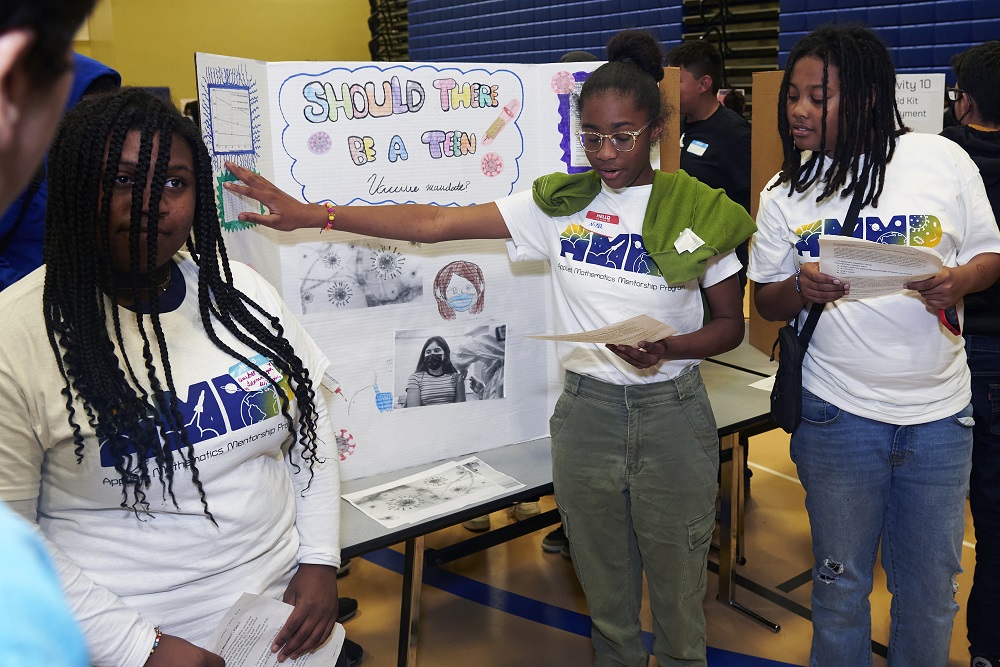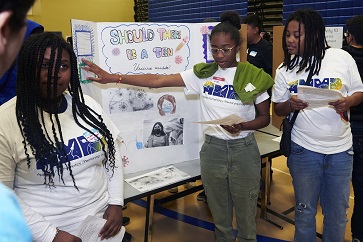UCLA collaboration fosters mathematical brilliance of Latino and Black middle school students
Undergraduates work in L.A. schools to bolster math learning through innovative research electives

Middle school students presented their research poster about whether there should be a vaccine mandate for teenagers. | Don Liebig/UCLA
Holly Ober | January 4, 2023
A program that brings together UCLA students, the Los Angeles Unified School District and professional engineers and technologists to enhance mathematics learning in select South Los Angeles middle schools has made its public debut.
Forget boring demonstrations of solving equations on a whiteboard or listening to long lectures about math. As part of the Applied Mathematics Mentorship Program, on Dec. 14 the middle school students presented the results of research projects that were connected to their communities. The projects included studying the impacts of heat islands and COVID-19 on their neighborhoods, and on aerospace efforts in South Los Angeles. The research investigations were created so students could apply the mathematics they learn in the classroom to investigate and analyze mathematical issues and opportunities in their neighborhoods.
“We’re trying to embed mirrors and windows into the student experience so they see mathematics as a field in which they belong,” said Heather Dallas, executive director of the Curtis Center for Mathematics and Teaching at UCLA.
Supported by a grant from the Bill & Melinda Gates Foundation, the Applied Mathematics Mentorship Program is a collaborative effort of the Curtis Center, three LAUSD middle schools, SpaceX engineers, FieldKit environmental technologists and the UCLA Myco-fluidics Lab.
The program places UCLA undergraduates as mentors at Barack Obama Global Preparatory Academy, William Jefferson Clinton Middle School, and Western Avenue T.E.C.H. Magnet School to support student research.
“It is important to show students mathematicians from their community doing mathematics for their community to inspire them to believe: I can do mathematics, I AM a mathematician,” Dallas said.
The program innovates mathematics learning by tapping into students’ innate desire to explore and understand the world around them. The effort highlights the relevance of mathematics and shows students how their community uses math to make a difference in the world.
The investigations are the brainchild of Dallas and Travis Holden, principal of Barack Obama Global Preparatory Academy and a UCLA alumnus who earned his bachelor’s degree in applied mathematics. Holden originally reached out to the Curtis Center to provide training for his mathematics department to implement a new textbook during the height of the pandemic.
The collaboration developed further when Dallas and Holden discussed a suggestion by an outside observer to involve the UCLA’s mathematics department in tutoring his middle school students.
“I told Heather I was big on not doing something remedial because I know that doesn’t work and it doesn’t excite kids,” Holden said. “I wanted to build on strengths our students already had. There’s a lot of research that says if you maintain high cognitive challenges during learning you see higher levels of learning.”
If research experiences during his time at UCLA excited him about mathematics, research could inspire his middle school students, too, he reasoned.
Dallas understood immediately, and pursued funding for a two-pronged effort: collaborate with mathematicians and scientists to develop relevant applied mathematics research investigations aligned to the school’s mathematics textbook and provide professional development for teachers and UCLA undergraduate mentors to facilitate the investigations. The Gates Foundation funded the effort and a research study of its effectiveness, which precipitated expansion to nearby Clinton Middle School and Western Avenue T.E.C.H.
Seventh-grade students collected data using devices from Los Angeles startup company, FieldKit to analyze heat islands in their communities. Heat islands occur in urban areas that experience higher temperatures compared to surrounding areas with more vegetation because buildings and roads reflect heat.
Eighth graders researched the disproportionate effects of COVID-19 on their community. In the Grade 9 investigation, student learned about aerospace endeavors in South Los Angeles, highlighting the experiences of local astronauts and SpaceX engineers of color.
“The 7th grade investigation places students in the driver seat to solve challenges in their own community. Students learn how to look at a problem, explore solutions and most importantly use their voice to bring upon change,” said Johnny Rivera, principal of Western T.E.C.H.
Cassandra Robbins, vice principal of Clinton Middle School, said that she sees students giving up on mathematics before they even start because it seems irrelevant to their goals. She said that the math interventions they have tried have not moved the students forward much, but the Curtis Center was not offering just another intervention.
“The Curtis Center came up with this idea that, similar to a physics class, you tie theory together with laboratory experience. It’s an addition to, not a replacement for regular math class,” Robbins said.
To study heat islands, for example, the students must learn about how materials absorb or reflect light, take accurate temperature readings, and apply mathematics to calculate averages. To study COVID, the students track and compare the spread of the illness in their own and surrounding communities. They do experiments and then graph, analyze and discuss the resulting data. In addition to applying grade-level mathematics, the students learn valuable lessons about teamwork and mathematical practice.
“It’s really great coaching them — they see me as a coach. They’re fully engaged,” said Jose Medel, who teaches a seventh grade elective on heat islands at Clinton Middle School.
The event, held at the Barack Obama Global Preparatory Academy, included a panel of STEM professionals of color, student research team poster presentations and a reception honoring their accomplishments.
This article originally appeared in the UCLA Newsroom. For more news and updates from the UCLA College, visit college.ucla.edu/news.




